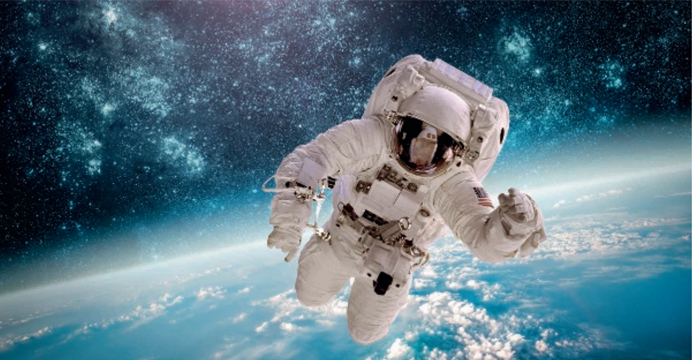
Weightlessness – Everyday life in space
Have you ever wondered what life is like for astronauts in space – how they eat, sleep, exercise or go to the bathroom? With Linde’s cylinders taking the leap into space, alongside the other equipment that Danish Aerospace Company (DAC) delivers to the International Space Station (ISS), we decided to find out more.
For more than 20 years, DAC has been purchasing specialty gasses and gas equipment from Linde. DAC, which is the only Danish company with a direct live feed from the ISS, develops and delivers equipment for use in space, including the respiratory equipment that measures astronauts’ heart and lung functions as they exercise on DAC’s specially designed exercise bikes. The measuring equipment on the bike also includes a modified Linde cylinder containing calibration gasses.
Keeping fit
“Exercise bikes are used for scientific research when conducting experiments with oxygen intake, for example,” explains Thomas A. E. Andersen, CEO of DAC. “But they are also used for exercise. If you are going to Mars and staying there, then it doesn’t matter. But you would like to come home again. When you have been in space for half a year and haven’t trained, then you can’t walk. When astronauts land, they are carried out and put in a reclining chair – despite the fact that they have exercised for two hours every day. Half a year in a weightless condition is like lying in bed for six months.”

The ISS astornauts takes part in several experiments in weighlessness. Here the NASA astronaut Rick Mastracchio is tested during exercice in the specially designed exercice bike..
Space is important for basic research in many scientific areas such as physics, chemistry, and biology and not least physiology and medicine. Common to all research projects is the effect of the unique condition of zero gravity in space.
Personal hygiene
Apart from its impact on the human body, weightlessness causes other complications for space travellers. As everything floats upwards in space, astronauts have to use no-rinse body baths and shampoos, originally developed for hospital patients who cannot take a shower. Meanwhile, a space station toilet is far more complex than the ones on Earth. While each crewmember has a small vacuum tube that is used to collect urine, solid matter is, well, another matter. Astronauts have to position themselves on the space toilet, using leg restraints and thigh-bar, before strapping onto the seat with a seatbelt. The toilet basically works like a vacuum cleaner with fans that suck air and waste into the commode, the contents of which eventually burn up upon re-entering Earth’s atmosphere.
Eating and sleeping
Astronauts on board the ISS experience 16 sunrises and sunsets every day, as the space station orbits Earth every 90 minutes, and sleep on average five to six hours a day. They sleep in sleeping bags that are attached to the wall and use earplugs to keep out the noise of the life-support systems that are continuously running, as well as the surrounding sounds of the space station.
The ISS kitchen area has tethers on the floor to hook feet into for astronauts who prefer to eat in a sitting position, but they often eat while floating around. Velcro is used to secure the various food containers on the table and prevent them from floating off. Most space food is freeze-dried, frozen, thermo-stabilised or ready-to-eat. As weightlessness tends to impair the sense of taste and smell, many astronauts report that they crave fare that is spicier and more tart than they would enjoy on Earth.
By:Isabelle Kliger
Photo: DAC
